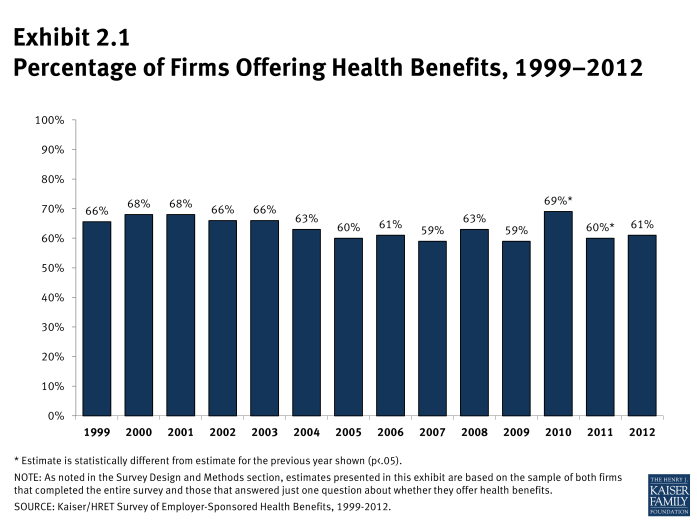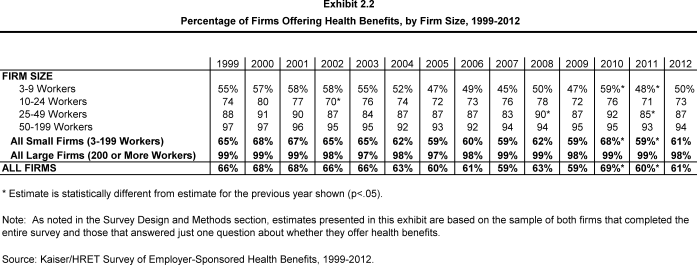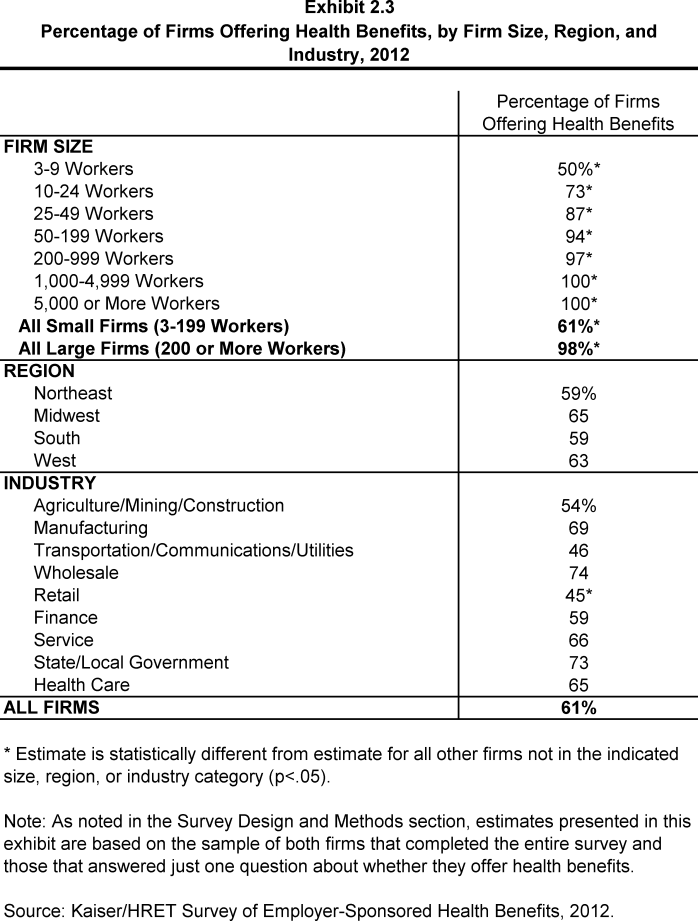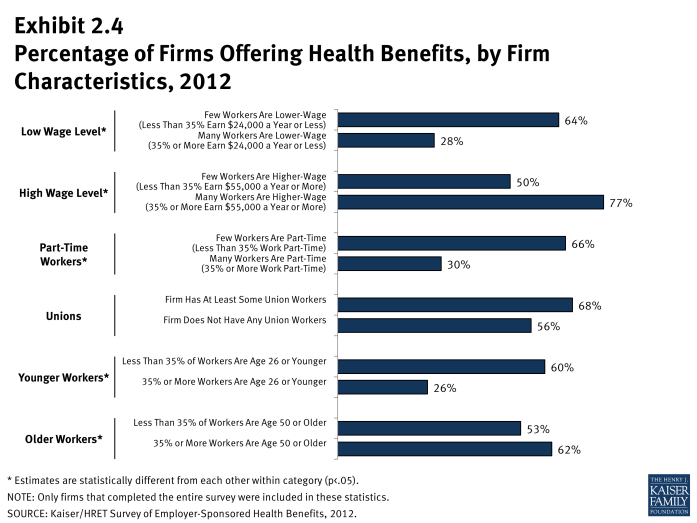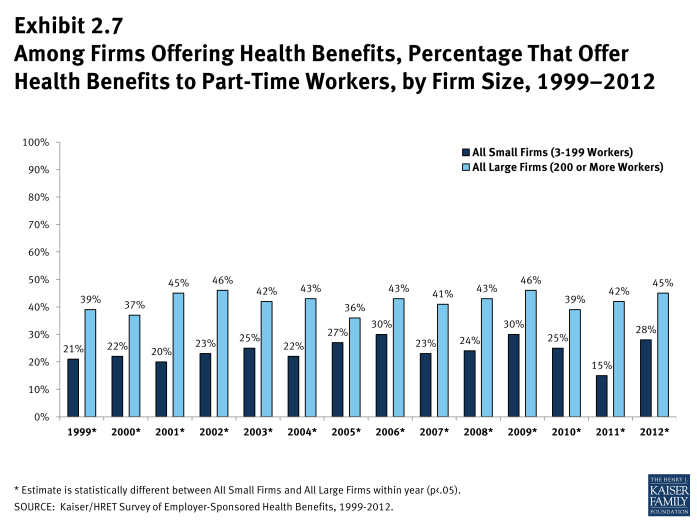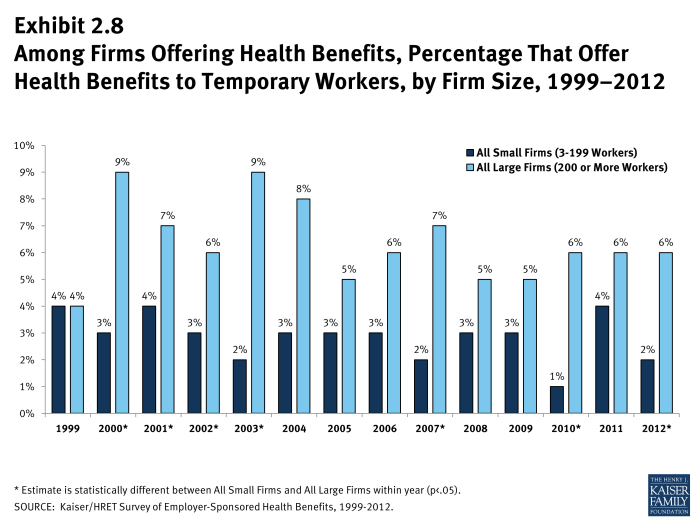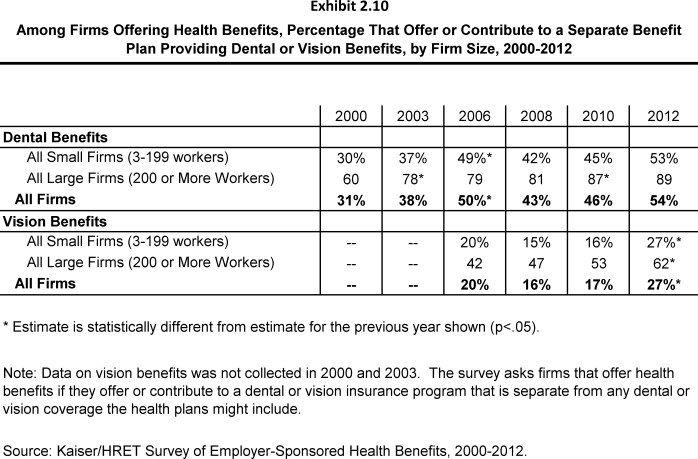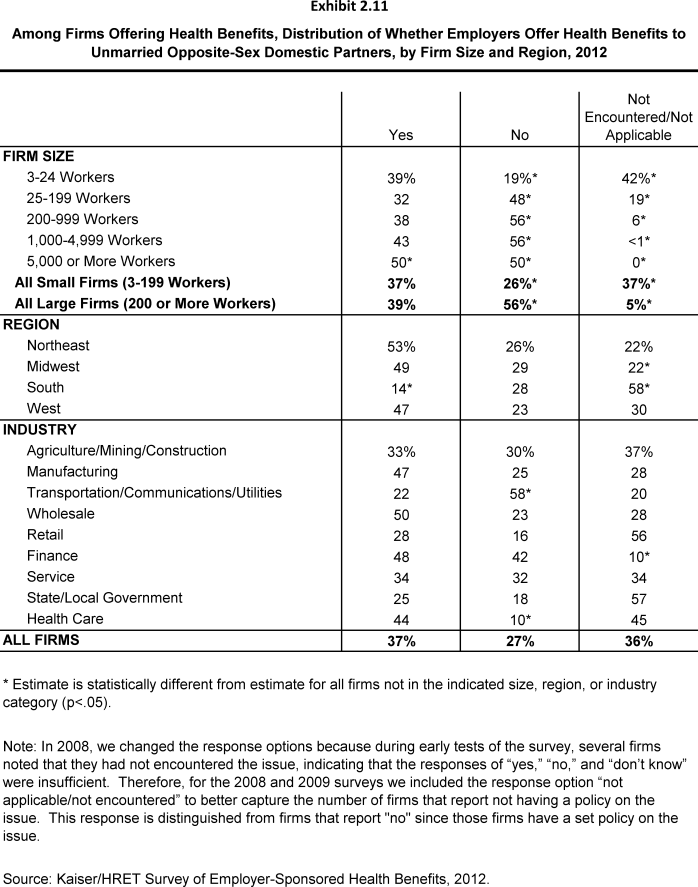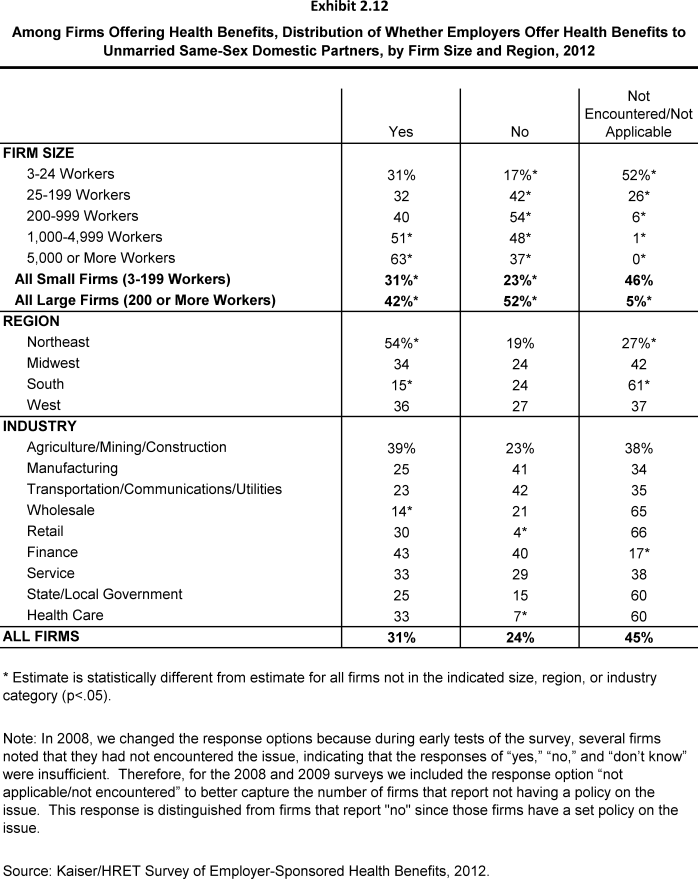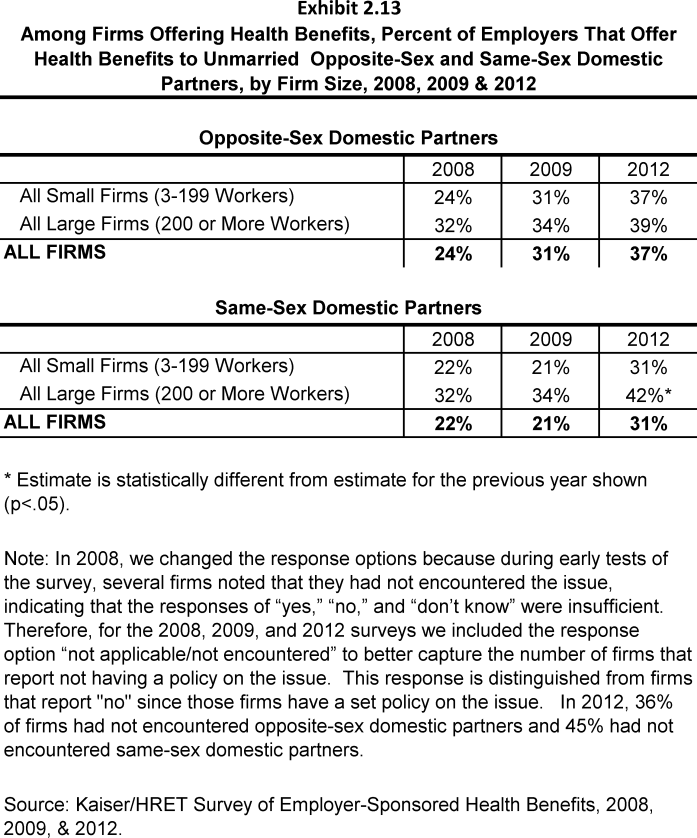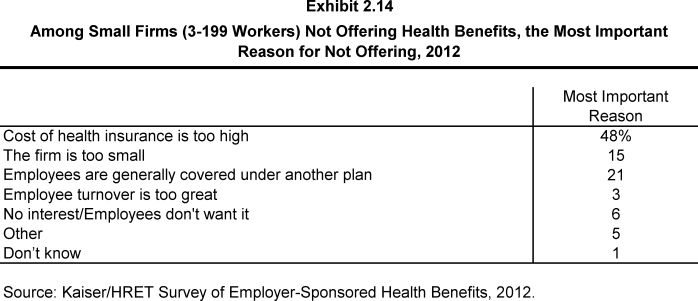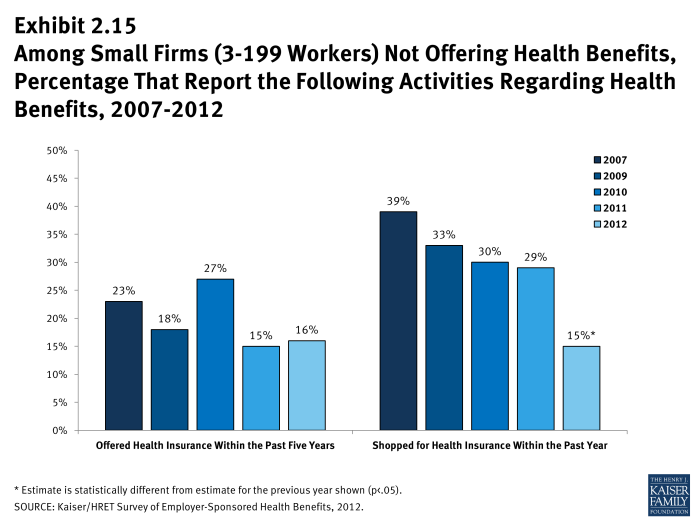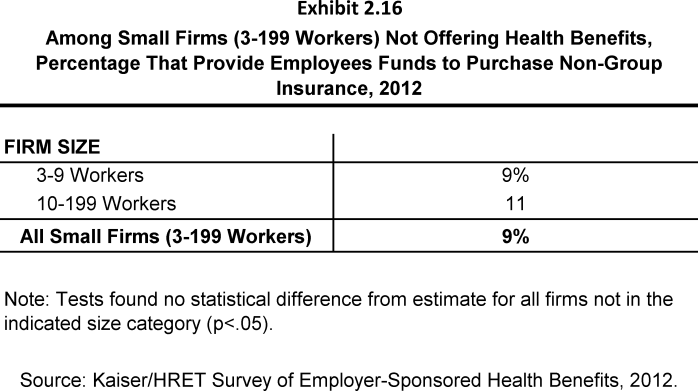2012 Employer Health Benefits Survey
Section 2: Health Benefit Offer Rates
While nearly all large firms (200 or more workers) offer health benefits, small firms (3-199 workers) are significantly less likely to do so. The percentage of all firms offering health benefits in 2012 (61%) is statistically unchanged from 2011 (60%), and also similar to the reported percentages from 2004 through 2009. 1
- In 2012, 61% of firms offer health benefits, unchanged from the 60% reported in 2011 (Exhibit 2.1).
- Similar to 2011, 98% of large firms (200 or more workers) offer health benefits in 2012 (Exhibit 2.2). In contrast, only 61% of small firms (3-199 workers) offer health benefits in 2012.
- Between 1999 and 2012, the offer rate for large firms (200 or more workers) has consistently remained at or above 97%. Among small firms (3-199 workers), the offer rate has varied from a high of 68% in 2000 and 2010, to a low of 59% in 2005, 2007, 2009, and 2011 (Exhibit 2.2). Since most firms in the country are small, variation in the overall offer rate is driven primarily by changes in the percentages of the smallest firms (3-9 workers) offering health benefits.
- Offer rates vary across different types of firms.
- Smaller firms are less likely to offer health insurance: 50% of firms with 3 to 9 workers offer coverage, compared to 73% of firms with 10 to 24 workers, 87% of firms with 25 to 49 workers, and 94% of firms with 50 to 199 employees (Exhibit 2.3).
- Firms with fewer lower-wage workers (less than 35% of workers earn $24,000 or less annually) are significantly more likely to offer health insurance than firms with many lower-wage workers (35% or more of workers earn $24,000 or less annually). While 64% of firms with fewer lower-wage workers offer health benefits, only 28% of firms with many lower-wage workers do (Exhibit 2.4). The offer rate for firms with many lower-wage workers is not significantly different from the 28% reported in 2011. We observe a similar pattern among firms with many higher-wage workers (35% or more of workers earn $55,000 or more annually) (Exhibit 2.4).
- The age of the workforce significantly affects the probability of a firm offering health benefits. Firms where 35% or more of its workers are age 26 or younger are less likely to offer health benefits than firms where less than 35% of workers are age 26 or younger (26% and 60%, respectively) (Exhibit 2.4).
- Among firms offering health benefits, relatively few offer benefits to their part-time and temporary workers.
- In 2012, 28% of all firms that offer health benefits offer them to part-time workers, a significant increase from the 16% reported in 2011 but similar to the 25% reported in 2010 (Exhibit 2.5). Firms with 200 or more workers are more likely to offer health benefits to part-time employees than firms with 3 to 199 workers (45% vs. 28%) (Exhibit 2.7).
- Consistently, a very small percentage (2% in 2012) of firms offering health benefits have offered them to temporary workers (Exhibit 2.6). The percentage of firms offering temporary workers benefits is lower at small firms (3-199 workers) than large firms (200 or more workers) (2% vs. 6%) (Exhibit 2.8).
Dental and Vision Benefits
- Fifty-four percent of firms offering health benefits offer or contribute to a dental insurance benefit for their employees that are separate from any dental coverage the health plans might include. This is not statistically different from the 46% reported in 2010, which is the last time we asked about dental benefits (Exhibit 2.10). Large firms (200 or more workers) are far more likely than small firms (3–199 workers) to offer or contribute to a separate dental health benefit, at 89% versus 53% (Exhibit 2.9).
- Twenty-seven percent of firms offer or contribute to a vision benefit for their employees that is separate from any vision coverage the health plan might include, which is significantly more than the 17% reported in 2010, the last time we asked about vision benefits (Exhibit 2.10). Though large firms (200 or more workers) are more likely than small firms (3–199 workers) to offer or contribute to a separate vision care benefit, at 62% versus 27% (Exhibit 2.9), significantly more firms in both groups offered vision benefits in 2012 compared with 2010 (Exhibit 2.10).
Domestic Partner Benefits
- In 2012, more firms offer benefits to unmarried opposite and same-sex domestic partners.
- In 2012, 37% of all firms offer health benefits to unmarried opposite-sex partners, while in 2009, 31% of firms did so. An even larger increase in the past four years may be observed in the percentage of firms offering health benefits to unmarried same-sex domestic partners. In 2009, 21% of all firms offered benefits to same-sex domestic partners; in 2012, this percentage increased to 31% of firms (Exhibit 2.13).
- When asked if they offer health benefits to opposite or same-sex domestic partners, however, many firms report that they have not encountered domestic partners. For example, many small firms may not have any employees who are in either an opposite or same-sex domestic partnerships. Regarding health benefits for opposite-sex domestic partners, 36% of firms report in 2012 that they have not encountered this need or that the question was not applicable. More small firms (37%) compared to large firms (5%) indicate that they have not encountered this need or that the question was not applicable (Exhibit 2.11). Regarding health benefits for same-sex domestic partners, 45% of firms report that they have not encountered the need or that the question was not applicable. More small firms (3–199 workers) (46%) than larger firms (5%) report that they have not encountered same-sex domestic partners (Exhibit 2.12).
- Firms in the Northeast are more likely (54%) and firms in the South are less likely (15%) to offer health benefits to unmarried same-sex domestic partners than firms in other regions (Exhibit 2.12). Similarly, firms in the South are less likely (14%) to offer health benefits to unmarried opposite-sex domestic partners than firms in other regions (Exhibit 2.11).
Firms Not Offering Health Benefits
- The survey asks firms that do not offer health benefits if they have offered insurance or shopped for insurance in the recent past, and about their most important reasons for not offering. Because such a small percentage of large firms report not offering health benefits, we present responses for the 39% of employers with 3 to 199 workers that do not offer health benefits.
- The cost of health insurance remains the primary reason cited by firms for not offering health benefits. Among small firms (3-199 workers) not offering health benefits, 48% cite high cost as “the most important reason” for not doing so, followed by: employees are covered elsewhere (21%) and firm is too small (15%) (Exhibit 2.14).
- Many non-offering small firms have either offered health benefits in the past five years, or shopped for coverage recently.
- Among non-offering small firms (3-199 workers), 9% report that they provide funds to their employees to purchase health insurance through the individual (non-group) market (Exhibit 2.16).
- Sixteen percent of non-offering small firms (3-199 workers) have offered health benefits in the past five years, while 15% have shopped for coverage in the past year (Exhibit 2.15). Sixteen percent of those that stopped offering within the past five years reported doing so in just the past 12 months.
x
Exhibit 2.1
x
Exhibit 2.2
x
Exhibit 2.3
x
Exhibit 2.4
x
Exhibit 2.5
x
Exhibit 2.7
x
Exhibit 2.6
x
Exhibit 2.8
x
Exhibit 2.10
x
Exhibit 2.9
x
Exhibit 2.13
x
Exhibit 2.11
x
Exhibit 2.12
x
Exhibit 2.14
x
Exhibit 2.16
x

